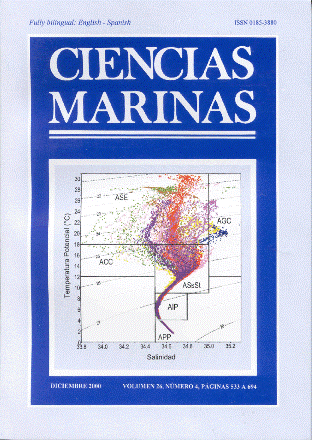Seasonal variation of the temperature and salinity at the entrance to the gulf of california, mexico
Main Article Content
Abstract
Seasonal variability at the entrance to the Gulf of California is described using high resolution CTD data from a section across the entrance to the gulf that was occupied eight times between 1992 and 1998. Variability decreased rapidly below 100 dbar, so that standard deviations exceeding 0.5ºC and 0.05 for temperature and salinity, respectively, were confined to the upper 150 dbar. The mean salinity field wasasymmetric, with fresher waters (S < 34.6) between 25 and 75 dbar next to Sinaloa and saltier waters (S > 34.8) above 50 dbar and between 100 and 150 dbar near Baja California. A seasonal thermocline developed in the upper 50 dbar, increasing from 21ºC in February surface temperatures to 31ºC in August. Below 100 dbar, temperature at a given pressure was typically colder in the center of the section, indicating cyclonic flow (flow into the gulf next to Sinaloa and out of the gulf next to Baja California). The subsurface mid-gulf cooling (cyclonic flow) was strongest during winter and spring when the exchange of heat between the gulf and the Pacific Ocean is large. Subsurface mid-gulf heating (corresponding to anticyclonic flow) was not observed. Temporal and spatial distribution of saline water masses suggests that heat exchanges take place by alternating the inflow and outflow of warm (surface) and cold (subsurface) water masses. The 1997–1998 El Niño resulted in a 50 dbar deepening of the thermocline in November 1997, as well as a freshening of 0.1 to 0.2 of waters above the thermocline.
Downloads
Article Details
This is an open access article distributed under a Creative Commons Attribution 4.0 License, which allows you to share and adapt the work, as long as you give appropriate credit to the original author(s) and the source, provide a link to the Creative Commons license, and indicate if changes were made. Figures, tables and other elements in the article are included in the article’s CC BY 4.0 license, unless otherwise indicated. The journal title is protected by copyrights and not subject to this license. Full license deed can be viewed here.

